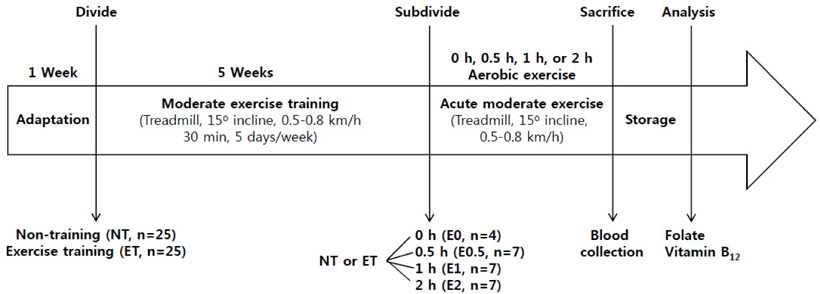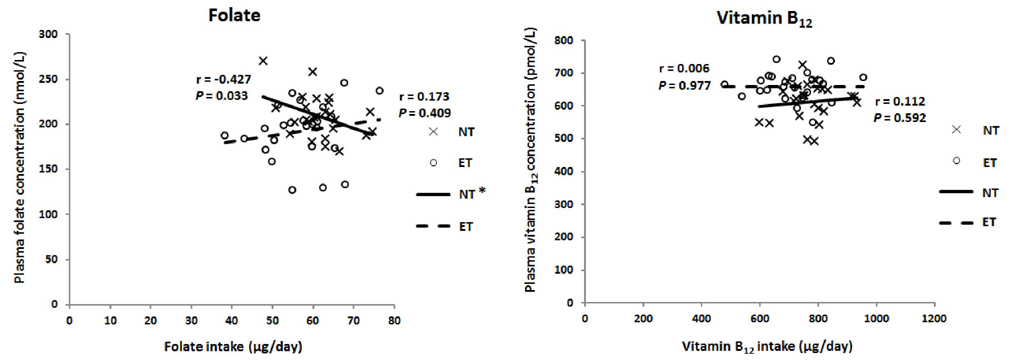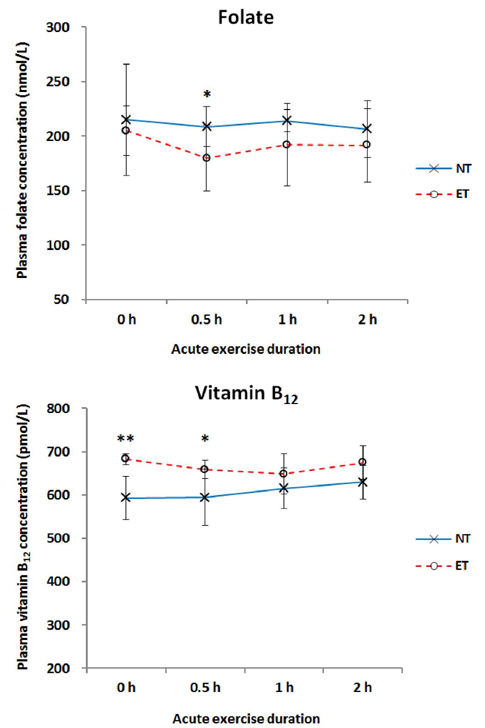Nutr Res Pract.
2016 Apr;10(2):161-166. 10.4162/nrp.2016.10.2.161.
The effects of exercise training and acute exercise duration on plasma folate and vitamin B12
- Affiliations
-
- 1Department of Food and Nutrition, Duksung Women's University, 33 Samyangro 144-gil, Dong-gu, Seoul 01369, Korea. yunokcho@duksung.ac.kr
- KMID: 2313913
- DOI: http://doi.org/10.4162/nrp.2016.10.2.161
Abstract
- BACKGROUND/OBJECTIVES
Energy production and the rebuilding and repair of muscle tissue by physical activity require folate and vitamin B12 as a cofactor. Thus, this study investigated the effects of regular moderate exercise training and durations of acute aerobic exercise on plasma folate and vitamin B12 concentrations in moderate exercise trained rats.
MATERIALS/METHODS
Fifty rats underwent non-exercise training (NT, n = 25) and regular exercise training (ET, n = 25) for 5 weeks. The ET group performed moderate exercise on a treadmill for 30 min/day, 5 days/week. At the end of week 5, each group was subdivided into 4 groups: non-exercise and 3 exercise groups. The non-exercise group (E0) was sacrificed without exercising and the 3 exercise groups were sacrificed immediately after exercising on a treadmill for 0.5 h (E0.5), 1 h (E1), and 2 h (E2). Blood samples were collected and plasma folate and vitamin B12 were analyzed.
RESULTS
After exercise training, plasma folate level was significantly lower and vitamin B12 concentration was significantly higher in the ET group compared with the NT group (P < 0.05). No significant associations were observed between plasma folate and vitamin B12 concentrations. In both the NT and ET groups, plasma folate and vitamin B12 were not significantly changed by increasing duration of aerobic exercise. Plasma folate concentration of E0.5 was significantly lower in the ET group compared with that in the NT group. Significantly higher vitamin B12 concentrations were observed in the E0 and E0.5 groups of the ET group compared to those of the NT group.
CONCLUSION
Regular moderate exercise training decreased plasma folate and increased plasma vitamin B12 levels. However, no significant changes in plasma folate and vitamin B12 concentrations were observed by increasing duration of acute aerobic exercise.
Keyword
MeSH Terms
Figure
Reference
-
1. Woolf K, Manore MM. B-vitamins and exercise: does exercise alter requirements? Int J Sport Nutr Exerc Metab. 2006; 16:453–484.
Article2. Coyle EF. Physical activity as a metabolic stressor. Am J Clin Nutr. 2000; 72:512S–520S.
Article3. Urhausen A, Weiler B, Coen B, Kindermann W. Plasma catecholamines during endurance exercise of different intensities as related to the individual anaerobic threshold. Eur J Appl Physiol Occup Physiol. 1994; 69:16–20.
Article4. Williams RS, Neufer PD. Regulation of gene expression in skeletal muscle by contractile activity. In : Rowell LB, Shepherd JT, editors. Handbook of Physiology. Section 12: Exercise: Regulation and Integration of Multiple Systems. Oxford: Oxford University Press;1996. p. 1124–1150.5. Herrmann M, Schorr H, Obeid R, Scharhag J, Urhausen A, Kindermann W, Herrmann W. Homocysteine increases during endurance exercise. Clin Chem Lab Med. 2003; 41:1518–1524.
Article6. Takahashi-Iñiguez T, García-Hernandez E, Arreguín-Espinosa R, Flores ME. Role of vitamin B12 on methylmalonyl-CoA mutase activity. J Zhejiang Univ Sci B. 2012; 13:423–437.7. Herrmann M, Wilkinson J, Schorr H, Obeid R, Georg T, Urhausen A, Scharhag J, Kindermann W, Herrmann W. Comparison of the influence of volume-oriented training and high-intensity interval training on serum homocysteine and its cofactors in young, healthy swimmers. Clin Chem Lab Med. 2003; 41:1525–1531.
Article8. Lira FS, Koyama CH, Yamashita AS, Rosa JC, Zanchi NE, Batista ML Jr, Seelaender MC. Chronic exercise decreases cytokine production in healthy rat skeletal muscle. Cell Biochem Funct. 2009; 27:458–461.
Article9. Campbell PT, Gross MD, Potter JD, Schmitz KH, Duggan C, McTiernan A, Ulrich CM. Effect of exercise on oxidative stress: a 12-month randomized, controlled trial. Med Sci Sports Exerc. 2010; 42:1448–1453.10. von Duvillard SP, Hamrm J, Lyerly GW, Moore JA, Durstine JL. Chapter 3. Utilization of fats in energy production. In : Wolinsky I, Driskell JA, editors. Sports Nutrition: Energy Metabolism and Exercise. Boca Raton (FL): CRC Press;2008. p. 47–62.11. Kim YN, Choi JY, Cho YO. Regular moderate exercise training can alter the urinary excretion of thiamin and riboflavin. Nutr Res Pract. 2015; 10:43–48.
Article12. Choi SK, Baek SH, Choi SW. The effects of endurance training and thiamine supplementation on anti-fatigue during exercise. J Exerc Nutr Biochem. 2013; 17:189–198.
Article13. Vallerand AL, Cuerrier JP, Shapcott D, Vallerand RJ, Gardiner PF. Influence of exercise training on tissue chromium concentrations in the rat. Am J Clin Nutr. 1984; 39:402–409.
Article14. Crozier PG, Cordain L, Sampson DA. Exercise-induced changes in plasma vitamin B-6 concentrations do not vary with exercise intensity. Am J Clin Nutr. 1994; 60:552–558.
Article15. Hyun T, Han YH, Lim EY. Blood folate level determined by a microplate reader and folate intake measure by a weighed food record. Korean J Community Nutr. 1999; 4:512–520.16. Forslund AH, Hambraeus L, van Beurden H, Holmbäck U, El-Khoury AE, Hjorth G, Olsson R, Stridsberg M, Wide L, Akerfeldt T, Regan M, Young VR. Inverse relationship between protein intake and plasma free amino acids in healthy men at physical exercise. Am J Physiol Endocrinol Metab. 2000; 278:E857–E867.17. Blomstrand E, Saltin B. BCAA intake affects protein metabolism in muscle after but not during exercise in humans. Am J Physiol Endocrinol Metab. 2001; 281:E365–E374.
Article18. Mourtzakis M, Saltin B, Graham T, Pilegaard H. Carbohydrate metabolism during prolonged exercise and recovery: interactions between pyruvate dehydrogenase, fatty acids, and amino acids. J Appl Physiol (1985). 2006; 100:1822–1830.
Article19. Dohm GL, Beecher GR, Warren RQ, Williams RT. Influence of exercise on free amino acid concentrations in rat tissues. J Appl Physiol Respir Environ Exerc Physiol. 1981; 50:41–44.
Article20. Joubert LM, Manore MM. Exercise, nutrition, and homocysteine. Int J Sport Nutr Exerc Metab. 2006; 16:341–361.
Article21. Jansson E, Kaijser L. Substrate utilization and enzymes in skeletal muscle of extremely endurance-trained men. J Appl Physiol (1985). 1987; 62:999–1005.
Article22. Holloszy JO, Kohrt WM. Regulation of carbohydrate and fat metabolism during and after exercise. Annu Rev Nutr. 1996; 16:121–138.
Article23. Horowitz JF, Klein S. Lipid metabolism during endurance exercise. Am J Clin Nutr. 2000; 72:558S–563S.
Article24. Kenney WL, Wilmore JH, Costill DL. Chapter 2. Fuel for exercise: bioenergetics and muscle metabolism. Physiology of Sport and Exercise. 6th ed. Champaign (IL): Human Kinetics;2015. p. 51–72.25. Choi EY, Cho YO. The influence of different durations of aerobic exercise on fuel utilization, lactate level and antioxidant defense system in trained rats. Nutr Res Pract. 2014; 8:27–32.
Article26. Deminice R, Vannucchi H, Simões-Ambrosio LM, Jordao AA. Creatine supplementation reduces increased homocysteine concentration induced by acute exercise in rats. Eur J Appl Physiol. 2011; 111:2663–2670.
Article27. Di Pasquale MG. Chapter 4. Utilization of proteins in energy metabolism. In : Wolinsky I, Driskell JA, editors. Sports Nutrition: Energy Metabolism and Exercise. Boca Raton (FL): CRC Press;2008. p. 63–123.28. Bailey DM, Davies B, Baker J. Training in hypoxia: modulation of metabolic and cardiovascular risk factors in men. Med Sci Sports Exerc. 2000; 32:1058–1066.
Article29. Deminice R, Rosa FT, Franco GS, da Cunha SF, de Freitas EC, Jordao AA. Short-term creatine supplementation does not reduce increased homocysteine concentration induced by acute exercise in humans. Eur J Nutr. 2014; 53:1355–1361.
Article30. Joubert LM, Manore MM. The role of physical activity level and B-vitamin status on blood homocysteine levels. Med Sci Sports Exerc. 2008; 40:1923–1931.
Article31. Randeva HS, Lewandowski KC, Drzewoski J, Brooke-Wavell K, O'Callaghan C, Czupryniak L, Hillhouse EW, Prelevic GM. Exercise decreases plasma total homocysteine in overweight young women with polycystic ovary syndrome. J Clin Endocrinol Metab. 2002; 87:4496–4501.
Article32. König D, Bissé E, Deibert P, Müller HM, Wieland H, Berg A. Influence of training volume and acute physical exercise on the homocysteine levels in endurance-trained men: interactions with plasma folate and vitamin B12. Ann Nutr Metab. 2003; 47:114–118.
Article
- Full Text Links
- Actions
-
Cited
- CITED
-
- Close
- Share
- Similar articles
-
- Effect of Endurance Training on the Plasma Homocysteine and B Vitamin Levels in Male Adolescent Field Hockey Players
- The Relationships of Health-Related Lifestyles with Homocysteine, Folate, and Vitamin B/sub 12/ Status in Korean Adults
- Plasma Homocysteine, Folate and Vitamin B12 Concentrations in Coronary Artery Disease
- Relationship of Folate, Vitamin B12, and Homocysteine to Anxiety and Depression in Epilepsy Patients
- Plasma Total Homocysteine, Folate and Vitamin B12 Concentrations in Patients with Coronary Stenosis





